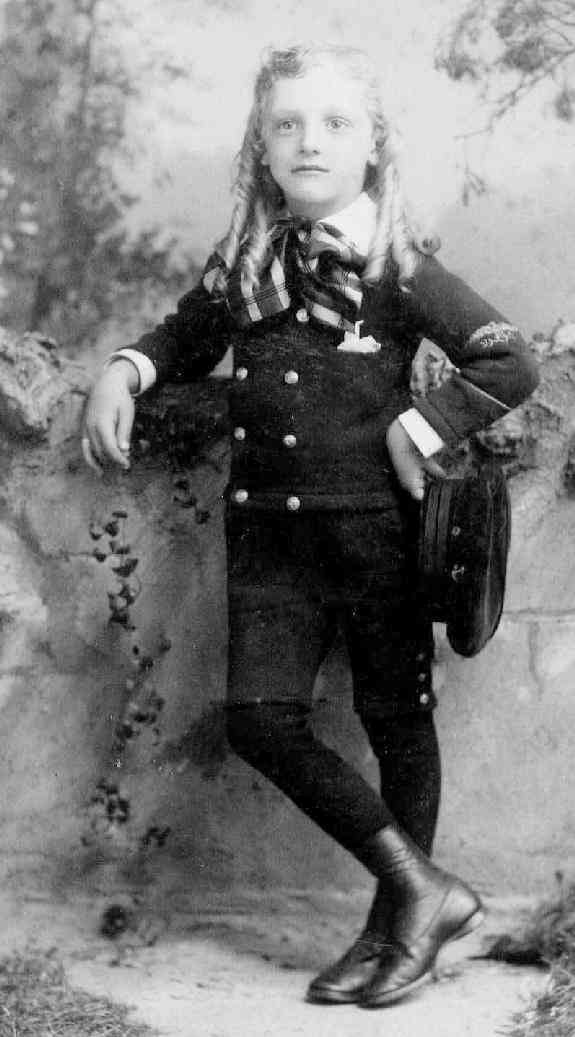

Figure 1.--This American boy was from Freehold, New Jersey. The portrait is undated, but we would estimate that it was probably taken about 1895. This boy looks to be about 8-9 years old. Curiously his hair at the forehead, depite the very defined ringlets, seems almost casual. His jacket has nautical touches including double breasted styling and an eagle on his sleeve. He may be wearing an Eton collar although it is largely covered by a large plaid floppy bow. Image courtesy of the RG collection.
|
New Jersey Boy: Ringlet Curls
This American boy was from Freehold, New Jersey. The portrait is undated, but we would estimate that it was probably taken about 1895. This boy looks to be about 8-9 years old. Curiously his hair at the forehead, depite the very defined ringlets, seems almost casual. Usually more care was given to the styling at the forehead as well. His jacket has nautical touches including double breasted styling and an eagle on his sleeve. Also notice the tam-like floppy sailor cap he is holding in his hand. This boy may be wearing an Eton collar although it is largely covered by a large plaid floppy bow.
The Boy
This portrait is unidentified. We know nothing about this American boy. He boy looks to be about 8-9 years old. We believe that he was from an affluent family. Not only would this hair style require coinsiderable work to maintain, also we do not believe this boy attended a regular school. It is likely a tutor was engaged to teach him at home.
Chronology
The portrait is undated, but we would estimate that it was probably taken about 1895. Lace collars were very common in the 1880s. Other styles like ruffked collars and Eton collars became more popular in the 1890s. The portrait fomat also seems more like the 1890s than the 1900s.
Location
This American boy was from Freehold, New Jersey. We know nothing about Freehold.
Clothing
His jacket has nautical touches including double breasted styling and an eagle on his sleeve. He does not have a sailor collar, but the double-breastd style was another jind f saior style. Also notice the tam-like floppy sailor cap he is holding in his hand. This boy may be wearing an Eton collar although it is largely covered by a large plaid floppy bow. His acket has a pocket witha white handkrtchief. He wears kneepoants, notice the three buttins at the hem, and black long stoickings.
Ringlets
Curiously his hair at the forehead, depite the very defined ringlets, seems almost casual. The ringlests are epecially long, extending well below the shoulders. Usually more care was given to the styling at the forehead as well. Notice how mother has carefully placed them so that they will show for best affect in the portrait.
Boy's Attitude
One of the interesting questions aout these old photographs is what the boys thought about their clothes and hair styles. The younger boys might not have given it a great deal of thought. Older boys like this are old enough to have their own ideas, although probably more influenced by mother than is the case today. Of ourse being schooled at home away from the influence of other boys would be a factor here. At any rate the pose and exprssion do not indicate that he objects to his ringlet curls.
With the popularity of ringlets during the Fauntleroy craze, some boys might wear ringlets longer, to 7 or 8 years. While most boys would have their curls cut by this age, it was not unknown for boys of 10 or 11 to still wear curls, in a few cases even to older ages. But this was much less common than the pre-school boys between age 3-6 years of ages. Here the variations in family attitudes was the major factor. There were not in the 19th century the same strong conventions concerning hair styles and clothing that exist today. In the days before modern media, mothers had much more lattitude concerning both hair styles and clothing. Even so, we believe that many of the older boys that wore ringlet curls were schooled at home. Except for nursery school children, there are virtually no images showing boys wearing ringlet curls to school. We believe that most of these older boys are from wealthy families that are being schooled at home. It was less complicated to keep yunger boys in ringlets. One they reached school age it wa more complicated. While aonventions on hair styling wereless set, at least for adults, this was not the case for boys. School age boys would virtually disdain a oy in ringlets. Thus almost all of the boys 7 years old and older would be booys that were being schooled at home. Away from the influence of other boys, mothers could better dictate both clothig and hair styling. And here many Americans had made substantial amounts of money in the industrial expansion of the country after the Civil War (1861-65). Many of the novea-rich families were anxious to show off their newly acquired wealth and social positioins. The ways they outfitted their children was one way of doing this. Whike younger boys could be kept in ringlets at no great cost, this was not the case for older boys. Home schooling in the 19th century often involved hiring tutors. As ringlet curls were more common in America than European countries and HBC has better access to America images, much of our assessment pertains to America. We are less sure about European trends.
Christopher Wagner

[Return to the Main ringlet curl age page]
[Return to the Main curl page]
[Bangs]
[Long hair]
[Fautleroy suits]
[Hair bows]
[Caps]
[Collar bows]
Navigate the Boys' Historical Clothing Web Site:
[Introduction]
[Activities]
[Biographies]
[Chronology]
[Clothing styles]
[Countries]
[Bibliographies]
[Contributions]
[FAQs]
[Italain glossary]
[Satellite sites]
[Tools]
[Boys' Clothing Home]
Created: January 13, 2003
Last edited: January 13, 20003



